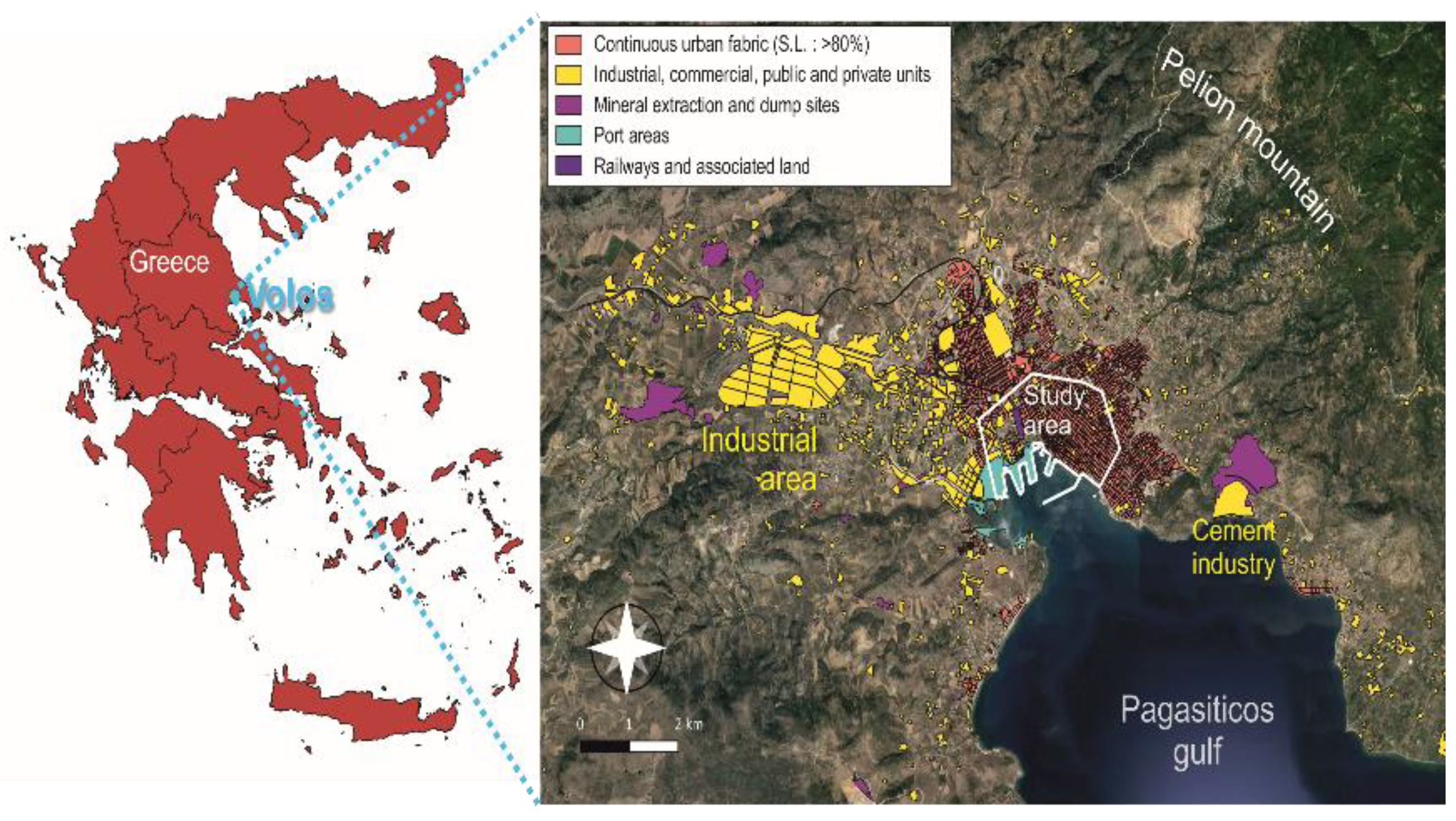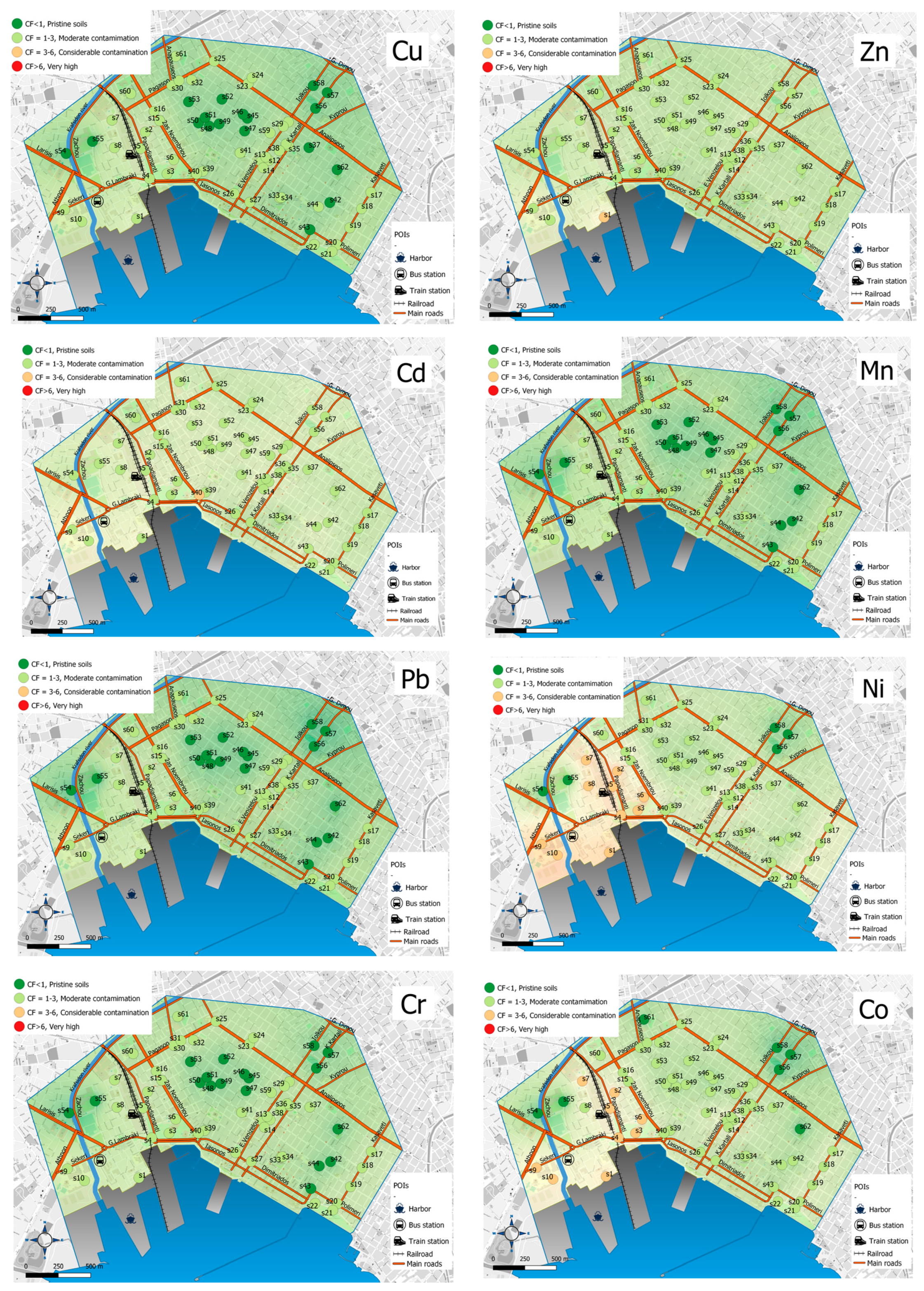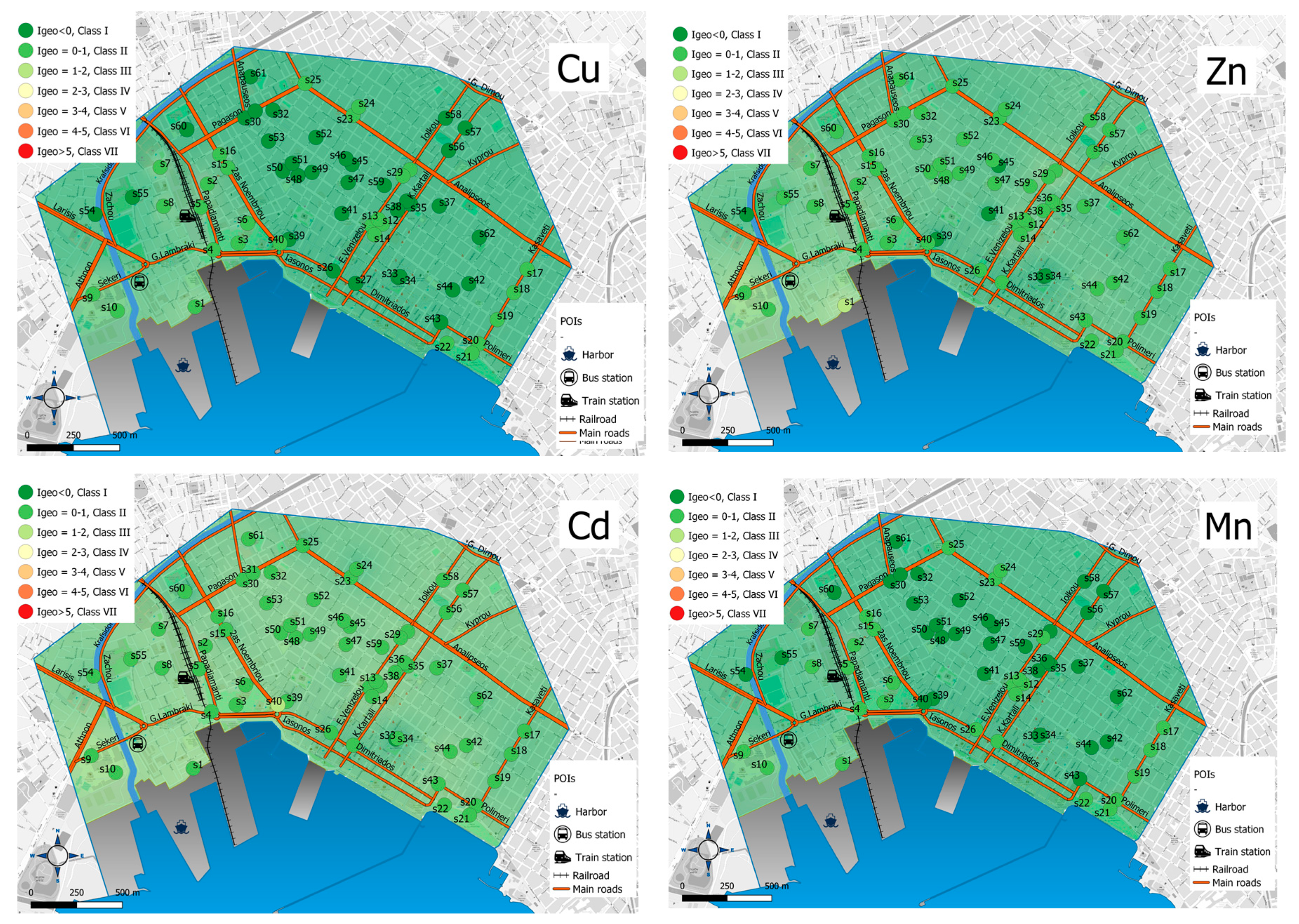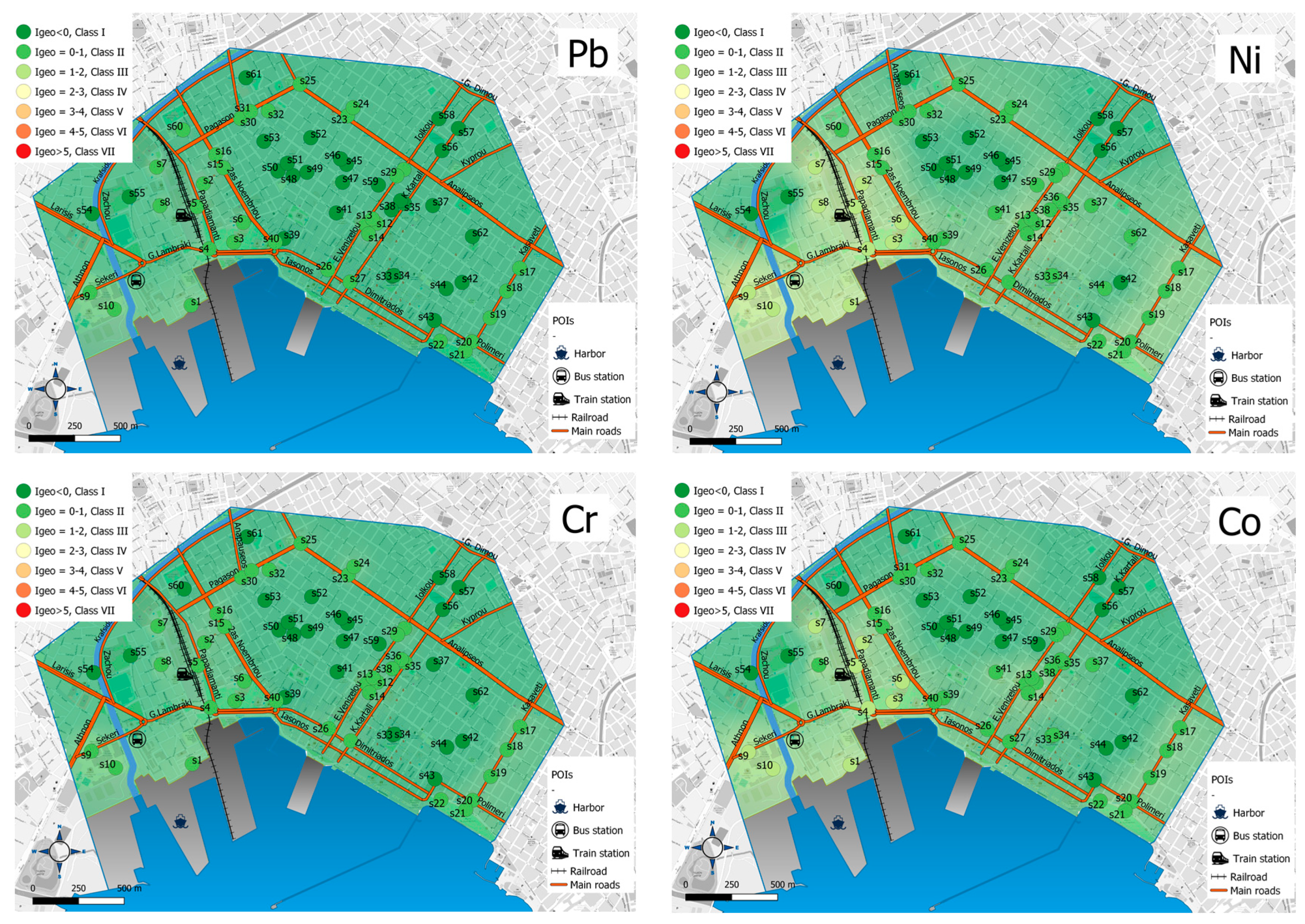Level of Contamination Assessment of Potentially Toxic Elements in the Urban Soils of Volos City (Central Greece)
Abstract
:1. Introduction
2. Materials and Methods
2.1. Site Description
2.2. Soil Sampling
2.3. Chemical Analysis of Soil Samples
2.4. Contamination Risk Assessment Indices of PTEs
2.5. Statistical and Geostatistical Procedures
3. Results
3.1. Physicochemical Properties of Soil Samples
3.2. Levels of Potentially Toxic Elements
3.3. Geostatistical analysis, Construction of Thematic Maps of Availability Indices of PTEs
4. Discussion
4.1. Physicochemical Properties of Soil Samples
4.2. Levels of Potentially Toxic Elements and Contamination Indices
4.3. Construction of Thematic Maps and Geostatistical Analysis
4.3.1. Maps of Contamination Factors
4.3.2. Maps of Geo-Accumulation Index
5. Conclusions
Supplementary Materials
Author Contributions
Funding
Institutional Review Board Statement
Informed Consent Statement
Data Availability Statement
Acknowledgments
Conflicts of Interest
References
- Pan, L.; Wang, Y.; Ma, J.; Hu, Y.; Su, B.; Fang, G.; Wang, L.; Xiang, B. A review of heavy metal pollution levels and health risk assessment of urban soils in Chinese cities. Environ. Sci. Pollut. Res. 2018, 25, 1055–1069. [Google Scholar] [CrossRef] [PubMed]
- Adimalla, N.; Chen, J.; Qian, H. Spatial characteristics of heavy metal contamination and potential human health risk assessment of urban soils: A case study from an urban region of South India. Ecotoxicol. Environ. Saf. 2020, 194. [Google Scholar] [CrossRef] [PubMed]
- Mehmood, K.; Ahmad, H.R.; Abbas, R.; Saifullah, R.; Murtaza, G. Heavy metals in urban and peri-urban soils of a heavily-populated and industrialized city: Assessment of ecological risks and human health repercussions. Hum. Ecol. Risk Assess. 2020, 26, 1705–1722. [Google Scholar] [CrossRef]
- Ok, Y.S.; Lee, S.S.; Jeon, W.T.; Oh, S.E.; Usman, A.R.A.; Moon, D.H. Application of eggshell waste for the immobilization of cadmium and lead in a contaminated soil. Environ. Geochem. Health 2011, 33, 31–39. [Google Scholar] [CrossRef]
- Kelepertzis, E.; Argyraki, A. Geochemical associations for evaluating the availability of potentially harmful elements in urban soils: Lessons learnt from Athens, Greece. Appl. Geochem. 2015, 59, 63–73. [Google Scholar] [CrossRef]
- Papadopoulou-Vrynioti, K.; Alexakis, D.; Bathrellos, G.D.; Skilodimou, H.D.; Vryniotis, D.; Vassiliades, E.; Gamvroula, D. Distribution of trace elements in stream sediments of Arta plain (western Hellas): The influence of geomorphological parameters. J. Geochem. Explor. 2013, 134, 17–26. [Google Scholar] [CrossRef]
- Hanfi, M.Y.; Mostafa, M.Y.A.; Zhukovsky, M. V Heavy metal contamination in urban surface sediments: Sources, distribution, contamination control, and remediation. Environ. Monit. Assess. 2020, 192, 1–21. [Google Scholar] [CrossRef]
- Adimalla, N. Heavy metals pollution assessment and its associated human health risk evaluation of urban soils from Indian cities: A review. Environ. Geochem. Health 2020, 42, 173–190. [Google Scholar] [CrossRef] [PubMed]
- Bathrellos, G.D.; Skilodimou, H.D.; Kelepertsis, A.; Alexakis, D.; Chrisanthaki, I.; Archonti, D. Environmental research of groundwater in the urban and suburban areas of Attica region, Greece. Environ. Geol. 2008, 56, 11–18. [Google Scholar] [CrossRef]
- Gamvroula, D.; Alexakis, D.; Stamatis, G. Diagnosis of groundwater quality and assessment of contamination sources in the Megara basin (Attica, Greece). Arab. J. Geosci. 2013, 6, 2367–2381. [Google Scholar] [CrossRef]
- Papadopoulou-Vrynioti, K.; Alexakis, D.; Bathrellos, G.D.; Skilodimou, H.D.; Vryniotis, D.; Vassiliades, E. Environmental research and evaluation of agricultural soil of the Arta plain, western Hellas. J. Geochemical Explor. 2014, 136, 84–92. [Google Scholar] [CrossRef]
- Alexakis, D.; Gotsis, D.; Giakoumakis, S. Evaluation of soil salinization in a Mediterranean site (Agoulinitsa district—West Greece). Arab. J. Geosci. 2015, 8, 1373–1383. [Google Scholar] [CrossRef]
- Han, Q.; Wang, M.; Cao, J.; Gui, C.; Liu, Y.; He, X.; He, Y.; Liu, Y. Health risk assessment and bioaccessibilities of heavy metals for children in soil and dust from urban parks and schools of Jiaozuo, China. Ecotoxicol. Environ. Saf. 2020, 191. [Google Scholar] [CrossRef] [PubMed]
- Wei, B.; Yang, L. A review of heavy metal contaminations in urban soils, urban road dusts and agricultural soils from China. Microchem. J. 2010, 94, 99–107. [Google Scholar] [CrossRef]
- Trujillo-González, J.M.; Torres-Mora, M.A.; Jiménez-Ballesta, R.; Zhang, J. Land-use-dependent spatial variation and exposure risk of heavy metals in road-deposited sediment in Villavicencio, Colombia. Environ. Geochem. Health 2019, 41, 667–679. [Google Scholar] [CrossRef]
- Gu, Y.G.; Gao, Y.P.; Lin, Q. Contamination, bioaccessibility and human health risk of heavy metals in exposed-lawn soils from 28 urban parks in southern China’s largest city, Guangzhou. Appl. Geochem. 2016, 67, 52–58. [Google Scholar] [CrossRef]
- Kowalska, J.B.; Mazurek, R.; Gąsiorek Michałand Zaleski, T. Pollution indices as useful tools for the comprehensive evaluation of the degree of soil contamination–A review. Environ. Geochem. Health 2018, 40, 2395–2420. [Google Scholar] [CrossRef] [Green Version]
- Massas, I.; Ehaliotis, C.; Kalivas, D.; Panagopoulou, G. Concentrations and availability indicators of soil heavy metals; The case of children’s playgrounds in the city of Athens (Greece). Water. Air. Soil Pollut. 2010, 212, 51–63. [Google Scholar] [CrossRef]
- Wijesiri, B.; Egodawatta, P.; McGree, J.; Goonetilleke, A. Process variability of pollutant build-up on urban road surfaces. Sci. Total Environ. 2015, 518–519, 434–440. [Google Scholar] [CrossRef] [Green Version]
- Seleznev, A.A.; Yarmoshenko, I.V.; Malinovsky, G.P. Assessment of total amount of surface sediment in urban environment using data on solid matter content in snow-dirt sludge. Environ. Process. 2019, 6, 581–595. [Google Scholar] [CrossRef]
- Alexakis, D.; Gamvroula, D.; Theofili, E. Environmental availability of potentially toxic elements in an agricultural Mediterranean site. Environ. Eng. Geosci. 2019, 25, 169–178. [Google Scholar] [CrossRef]
- Mehmood, K.; Chang, S.; Yu, S.; Wang, L.; Li, P.; Li, Z.; Liu, W.; Rosenfeld, D.; Seinfeld, J.H. Spatial and temporal distributions of air pollutant emissions from open crop straw and biomass burnings in China from 2002 to 2016. Environ. Chem. Lett. 2018, 16, 301–309. [Google Scholar] [CrossRef]
- Tong, S.; Li, H.; Li, W.; Tudi, M.; Yang, L. Concentration, spatial distribution, contamination degree and human health risk assessment of heavy metals in urban soils across china between 2003 and 2019—A systematic review. Int. J. Environ. Res. Public Health 2020, 17, 3099. [Google Scholar] [CrossRef]
- Guo, G.; Wu, F.; Xie, F.; Zhang, R. Spatial distribution and pollution assessment of heavy metals in urban soils from southwest China. J. Environ. Sci. 2012, 24, 410–418. [Google Scholar] [CrossRef]
- Zhang, X.; Wei, S.; Sun, Q.; Wadood, S.A.; Guo, B. Source identification and spatial distribution of arsenic and heavy metals in agricultural soil around Hunan industrial estate by positive matrix factorization model, principle components analysis and geo statistical analysis. Ecotoxicol. Environ. Saf. 2018, 159, 354–362. [Google Scholar] [CrossRef] [PubMed]
- Saha, N.; Rahman, M.S.; Jolly, Y.N.; Rahman, A.; Sattar, M.A.; Hai, M.A. Spatial distribution and contamination assessment of six heavy metals in soils and their transfer into mature tobacco plants in Kushtia District, Bangladesh. Environ. Sci. Pollut. Res. 2016, 23, 3414–3426. [Google Scholar] [CrossRef]
- Khoder, M.; Al Ghamdi, M.; Shiboob, M. Heavy Metal Distribution in Street Dust of Urban and Industrial Areas in Jeddah, Saudi Arabia. J. King Abdulaziz Univ. Environ. Arid L. Agric. Sci. 2012, 23, 55–75. [Google Scholar] [CrossRef]
- Logiewa, A.; Miazgowicz, A.; Krennhuber, K.; Lanzerstorfer, C. Variation in the concentration of metals in road dust size fractions between 2 µm and 2 mm: Results from three metallurgical centres in Poland. Arch. Environ. Contam. Toxicol. 2020, 78, 46–59. [Google Scholar] [CrossRef] [PubMed] [Green Version]
- Botsou, F.; Moutafis, I.; Dalaina, S.; Kelepertzis, E. Settled bus dust as a proxy of traffic-related emissions and health implications of exposures to potentially harmful elements. Atmos. Pollut. Res. 2020, 11, 1776–1784. [Google Scholar] [CrossRef]
- Kelepertzis, E.; Argyraki, A.; Chrastný, V.; Botsou, F.; Skordas, K.; Komárek, M.; Fouskas, A. Metal(loid) and isotopic tracing of Pb in soils, road and house dusts from the industrial area of Volos (central Greece). Sci. Total Environ. 2020, 725. [Google Scholar] [CrossRef]
- Christoforidis, A.; Stamatis, N. Heavy metal contamination in street dust and roadside soil along the major national road in Kavala’s region, Greece. Geoderma 2009, 151, 257–263. [Google Scholar] [CrossRef]
- McLaughlin, M.J.; Zarcinas, B.A.; Stevens, D.P.; Cook, N. Soil testing for heavy metals. Commun. Soil Sci. Plant Anal. 2000, 31, 1661–1700. [Google Scholar] [CrossRef]
- Page, A.L. Methods of soil analysis-Part 2: Chemical and microbiological properties. In American Sociaty of Agronomy, 2nd ed.; Phosphurus Inc.: Madison, WI, USA, 1982; Volume 9, pp. 421–422. [Google Scholar]
- ISO. Environment Soil Quality; ISO/DIS 11466; ISO Standards Compendium: Switzerland, Geneva, 1994. [Google Scholar]
- Golia, E.E.; Tsiropoulos, N.G.; Dimirkou, A.; Mitsios, I. Distribution of heavy metals of agricultural soils of central Greece using the modified BCR sequential extraction method. Int. J. Environ. Anal. Chem. 2007, 87, 1053–1063. [Google Scholar] [CrossRef]
- Council of the European Communities. The protection of the environment, and in particular of the soil, when sewage sludge is used in agriculture; Council Directive of 12 June 1986. Off. J. Eur. Commun. 1986, 181, 6. [Google Scholar]
- Meharg, A.A. Trace Elements in Soils and Plants, 4th ed.; Kabata-Pendias, A., Ed.; CRC Press/Taylor & Francis Group: Boca Raton, FL, USA, 2010; ISBN 9781420093704. [Google Scholar]
- Antoniadis, V.; Golia, E.E.; Shaheen, S.M.; Rinklebe, J. Bioavailability and health risk assessment of potentially toxic elements in Thriasio Plain, near Athens, Greece. Environ. Geochem. Health 2017, 39, 319–330. [Google Scholar] [CrossRef]
- Mueller, G. Schwermetalle in Den Sedimenten Des Rheins—Veranderungen Seit 1971. Umsch. Wissensch. Techn. 1979, 79, 778–783. [Google Scholar]
- Kasa, E.; Felix-Henningsen, P.; Duering, R.A.; Gjoka, F. The occurrence of heavy metals in irrigated and non-irrigated arable soils, NW Albania. Environ. Monit. Assess. 2014, 186, 3595–3603. [Google Scholar] [CrossRef]
- Ding, Q.; Shi, X.; Zhuang, D.; Wang, Y. Temporal and spatial distributions of ecological vulnerability under the influence of natural and anthropogenic factors in an eco-province under construction in China. Sustainability 2018, 10, 87. [Google Scholar] [CrossRef] [Green Version]
- Johnson, R.A.; Wichern, D.W. Applied Multivariate Statistical Analysis, 6th ed.; Prentice-Hall: Hoboken, NJ, USA, 2007. [Google Scholar]
- SAGA User Group Association. SAGA 7.9.0—System for Automated Geoscientific Analyses. Available online: http://www.saga-gis.org (accessed on 29 December 2020).
- QGIS Development Team. QGIS Geographic Information System. Available online: http://qgis.osgeo.org (accessed on 10 December 2020).
- Shirani, M.; Afzali, K.N.; Jahan, S.; Strezov, V.; Soleimani-Sardo, M. Pollution and contamination assessment of heavy metals in the sediments of Jazmurian playa in southeast Iran. Sci. Rep. 2020, 10. [Google Scholar] [CrossRef] [PubMed]
- Antoniadis, V.; Golia, E.E. Sorption of Cu and Zn in low organic matter-soils as influenced by soil properties and by the degree of soil weathering. Chemosphere 2015, 138, 364–369. [Google Scholar] [CrossRef] [PubMed]
- Wu, Y.; Lu, X.; Zhuang, S.; Han, X.; Zhou, Y. Contamination characteristics and assessment of manganese, Zinc, Chrome, Lead, Copper and Nickel in Bus Station Dusts of Xifeng, Northwest China. Preprints 2016, 1–13. [Google Scholar] [CrossRef] [Green Version]
- Antoniadis, V.; Golia, E.E.; Liu, Y.T.; Wang, S.L.; Shaheen, S.M.; Rinklebe, J. Soil and maize contamination by trace elements and associated health risk assessment in the industrial area of Volos, Greece. Environ. Int. 2019, 124, 79–88. [Google Scholar] [CrossRef]
- Ivankovic, N.; Kasanin-Grubin, M.; Brceski, I.; Vukelic, N. Possible sources of heavy metals in urban soils: Example from Belgrade, Serbia. J. Environ. Prot. Ecol. 2010, 11, 455–464. [Google Scholar]
- Briggs, D.J. The use of GIS to evaluate traffic-related pollution. Occup. Environ. Med. 2007, 64, 1–2. [Google Scholar] [CrossRef] [PubMed] [Green Version]
- Isaaks, E.H.; Srivastava, R.M. An Introduction to Applied Geostatistics; Oxford University Press: New York, NY, USA, 1989. [Google Scholar]
- Mihailović, A.; Budinski-Petković, L.; Popov, S.; Ninkov, J.; Vasin, J.; Ralević, N.M.; Vasić, M.V. Spatial distribution of metals in urban soil of Novi Sad, Serbia: GIS based approach. J. Geochemical Explor. 2015, 150, 104–114. [Google Scholar] [CrossRef]
- Kerry, R.; Oliver, M.A. Determining nugget:sill ratios of standardized variograms from aerial photographs to krige sparse soil data. Precis. Agric. 2008, 9, 33–56. [Google Scholar] [CrossRef]
- Zhang, Y.; Lu, H.; Qu, W. Geographical detection of traffic accidents spatial stratified heterogeneity and influence factors. Int. J. Environ. Res. Public Health 2020, 17, 572. [Google Scholar] [CrossRef] [PubMed] [Green Version]
- Wu, Y.; Lu, X. Physicochemical properties and toxic elements in bus stop dusts from Qingyang, NW China. Sci. Rep. 2018, 8. [Google Scholar] [CrossRef] [PubMed] [Green Version]
- Jahan, S.; Strezov, V. Assessment of trace elements pollution in the sea ports of New South Wales (NSW), Australia using oysters as bioindicators. Sci. Rep. 2019, 9. [Google Scholar] [CrossRef]
- Rizo, O.D.; Hernández, I.C.; López, J.A.; Arado, O.D.; Pino, N.L.; Rodríguez, K.D. Chromium, cobalt and nickel contents in urban soils of Moa, northeastern Cuba. Bull. Environ. Contam. Toxicol. 2011, 86, 189–193. [Google Scholar] [CrossRef]
- Maeaba, W.; Prasad, S.; Chandra, S. First assessment of metals contamination in road dust and roadside soil of Suva City, Fiji. Arch. Environ. Contam. Toxicol. 2019, 77, 249–262. [Google Scholar] [CrossRef] [PubMed] [Green Version]
- Różański, S.; Jaworska, H.; Matuszczak, K.; Nowak, J.; Hardy, A. Impact of highway traffic and the acoustic screen on the content and spatial distribution of heavy metals in soils. Environ. Sci. Pollut. Res. 2017, 24, 12778–12786. [Google Scholar] [CrossRef] [PubMed] [Green Version]
- Szwalec, A.; Mundała, P.; Kędzior, R.; Pawlik, J. Monitoring and assessment of cadmium, lead, zinc and copper concentrations in arable roadside soils in terms of different traffic conditions. Environ. Monit. Assess. 2020, 192. [Google Scholar] [CrossRef] [PubMed] [Green Version]
- Navarro, M.; D’Agostino, A.; Neri, L. The effect of urbanization on subjective well-being: Explaining cross-regional differences. Socioecon. Plann. Sci. 2020, 71. [Google Scholar] [CrossRef]
- Vaiškūnaitė, R.; Jasiūnienė, V. The analysis of heavy metal pollutants emitted by railway transport. Transport 2020, 35, 213–223. [Google Scholar] [CrossRef]




| Descriptive Statistics | pH (1:1) | EC (μS cm−1) | OΜ (%) | Clay (%) | Sand (%) | CaCO3 (%) |
|---|---|---|---|---|---|---|
| Minimum Value | 6.57 | 1123.00 | 0.30 | 2 | 22 | 9.61 |
| Maximum Value | 8.92 | 6957.46 | 4.40 | 52 | 78 | 20.54 |
| Mean Value | 7.44 | 3235.60 | 2.44 | 19 | 57 | 14.57 |
| Relative Standard Deviation | 0.41 | 12.76 | 0.91 | 7.50 | 6.99 | 1.54 |
| Kurtosis Coefficient | 1.415 | −0.495 | −0.676 | −0.006 | −0.071 | −0.680 |
| Skewness Coefficient | 0.710 | 0.747 | −0.128 | 1.0096 | −0.932 | 0.231 |
| . | Cu | Zn | Pb | Ni | Cd | Co | Cr | Mn |
|---|---|---|---|---|---|---|---|---|
| . | mg kg−1 | |||||||
| Minimum Value | 28.90 | 88.42 | 5.43 | 24.98 | 0.57 | 4.62 | 26.07 | 254.33 |
| 10th-perc a | 33.91 | 106.17 | 13.05 | 32.96 | 0.71 | 10.81 | 47.72 | 308.64 |
| 50th-perc b | 51.48 | 126.40 | 41.31 | 63.41 | 0.96 | 22.38 | 110.86 | 714.13 |
| Average | 53.91 | 131.02 | 35.94 | 67.28 | 0.94 | 22.56 | 93.24 | 663.71 |
| 90th-perc c | 80.26 | 166.07 | 55.12 | 114.86 | 1.14 | 35.40 | 122.33 | 942.59 |
| Maximum Value | 89.27 | 218.11 | 58.14 | 117.89 | 1.25 | 38.14 | 123.25 | 951.18 |
| EU Limits d | 140 | 300 | 300 | 75 | 3 | - | 200 | - |
| BG (mg kg−1) e | 24.57 | 64.35 | 29.69 | 22.92 | 0.49 | 9.62 | 23.84 | 540.13 |
| CF | Cu | Zn | Pb | Ni | Cd | Co | Cr | Mn |
|---|---|---|---|---|---|---|---|---|
| Descriptive statistics | ||||||||
| Mean Value | 1.38 | 1.85 | 1.30 | 2.32 | 2.27 | 3.99 | 2.21 | 1.34 |
| Standard Deviation | 0.46 | 0.40 | 0.62 | 0.99 | 0.43 | 1.72 | 1.21 | 0.50 |
| Minimum Value | 0.74 | 1.15 | 0.09 | 0.86 | 1.20 | 0.15 | 0.19 | 0.48 |
| Maximum Value | 2.30 | 3.12 | 2.15 | 4.07 | 3.06 | 6.75 | 3.91 | 1.95 |
| Skewness Coefficient | 0.401 | 1.018 | −0.381 | 0.368 | −0.405 | −0.234 | 0.120 | −0.360 |
| Kurtosis Coefficient | −1.016 | 1.249 | −1.177 | −0.935 | −0.650 | −0.796 | −1.583 | −1.373 |
| Geostatistical parameters | ||||||||
| Model | Cubic | Exp. | Exp. | Exp. | Spher. | Spher. | Spher. | Spher. |
| Nugget | 0.017 | 0.004 | 0.109 | 0.143 | 0.064 | 0.016 | 0.027 | 0.026 |
| Range | 985 | 985 | 973 | 1209 | 981 | 984 | 996 | 985 |
| Sill | 0.231 | 0.176 | 0.426 | 1.191 | 0.198 | 0.833 | 0.488 | 0.207 |
| Slope | - | - | - | - | - | - | - | - |
| Nugget sill ratio | 0.08 | 0.02 | 0.26 | 0.12 | 0.32 | 0.02 | 0.05 | 0.13 |
| R2 | 0.53 | 0.68 | 0.40 | 0.47 | 0.60 | 0.64 | 0.46 | 0.30 |
| Igeo | Cu | Zn | Pb | Ni | Cd | Co | Cr | Mn |
|---|---|---|---|---|---|---|---|---|
| Descriptive statistics | ||||||||
| Mean Value | −0.20 | 0.27 | −0.47 | 0.49 | 0.57 | 1.20 | 6.18 | −0.28 |
| Standard Deviation | 0.48 | 0.29 | 1.02 | 0.66 | 0.29 | 0.96 | 0.98 | 0.64 |
| Minimum Value | −1.01 | −0.38 | −4.14 | −0.80 | −0.33 | −3.31 | 2.91 | −1.65 |
| Maximum Value | 0.61 | 1.05 | 0.52 | 1.44 | 1.03 | 2.17 | 7.28 | 0.38 |
| Skewness Coefficient | 0.007 | 0.400 | −1.379 | −0.285 | −0.819 | −2.218 | −0.777 | −0.712 |
| Kurtosis Coefficient | −1.262 | 0.225 | 1.644 | −0.893 | 0.253 | 7.210 | 0.416 | −0.942 |
| Geostatistical parameters | ||||||||
| Model | Exp. | Exp. | Cubic | Cubic | Exp. | Spher. | Cubic | Exp. |
| Nugget | 0.055 | 0.004 | 0.031 | 0.006 | 0.001 | 0.031 | 0.006 | 0.082 |
| Range | 985 | 984 | 979 | 971 | 983 | 995 | 846 | 983 |
| Sill | 0.272 | 0.093 | 1.140 | 0.490 | 0.095 | 0.655 | 0.386 | 0.443 |
| Slope | - | - | - | - | - | - | - | - |
| Nugget sill ratio | 0.20 | 0.04 | 0.03 | 0.01 | 0.01 | 0.05 | 0.01 | 0.19 |
| R2 | 0.49 | 0.66 | 0.50 | 0.52 | 0.60 | 0.65 | 0.46 | 0.34 |
Publisher’s Note: MDPI stays neutral with regard to jurisdictional claims in published maps and institutional affiliations. |
© 2021 by the authors. Licensee MDPI, Basel, Switzerland. This article is an open access article distributed under the terms and conditions of the Creative Commons Attribution (CC BY) license (http://creativecommons.org/licenses/by/4.0/).
Share and Cite
Golia, E.E.; Papadimou, S.G.; Cavalaris, C.; Tsiropoulos, N.G. Level of Contamination Assessment of Potentially Toxic Elements in the Urban Soils of Volos City (Central Greece). Sustainability 2021, 13, 2029. https://0-doi-org.brum.beds.ac.uk/10.3390/su13042029
Golia EE, Papadimou SG, Cavalaris C, Tsiropoulos NG. Level of Contamination Assessment of Potentially Toxic Elements in the Urban Soils of Volos City (Central Greece). Sustainability. 2021; 13(4):2029. https://0-doi-org.brum.beds.ac.uk/10.3390/su13042029
Chicago/Turabian StyleGolia, Evangelia E., Sotiria G. Papadimou, Christos Cavalaris, and Nikolaos G. Tsiropoulos. 2021. "Level of Contamination Assessment of Potentially Toxic Elements in the Urban Soils of Volos City (Central Greece)" Sustainability 13, no. 4: 2029. https://0-doi-org.brum.beds.ac.uk/10.3390/su13042029







